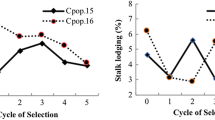Summary
Results of 5 generations of selection for improved productivity in corn by selecting for prolificacy, a correlated trait, are reported. The regression for gain in yield per cycle of selection relative to the parental variety, Hays Golden, was 6.28%. This compares favorably with a previously reported gain from mass selection in the same variety using weight of grain per plant as the selection trait. The greater effectiveness of selection where prolificacy was the primary trait is believed due to higher selection intensity used as well as higher heritability.
Zusammenfassung
Die Ergebnisse einer über 5 Generationen durchgeführten Selektion auf Erhöhung der Ertragsfähigkeit bei Mais werden mitgeteilt. Es wurde auf Fruchtbarkeit (Anzahl gut entwickelter Kolben), ein korreliertes Merkmal, ausgelesen. Die Regression für den Ertragszuwachs je Selektionszyklus betrug, bezogen auf die elterliche Sorte ‘Hays Golden’, 6,28%. Das stimmt gut mit einem früher schon berichteten Anstieg nach Massenselektion der gleichen Sorte überein, wo als Selektionsmerkmal das Korngewicht je Pflanze diente. Das bessere Ergebnis der Selektion auf Fruchtbarkeit wird auf die angewendete größere Selektionsintensität und die höhere Heritabilität zurückgeführt.
Similar content being viewed by others
Literature cited
Compton, W. A., C. O. Gardner and J. H. Lonnquist: Genetic variability in two open-pollinated varieties of corn (Zea mays L.) and their F 1 progenies. Crop Science 5, 505–508 (1965).
Comstock, R. E., and H. F. Robinson: The components of genetic variance in populations of biparental progenies and their use in estimating the average degree of dominance. Biometrics 4, 254–266 (1948).
Falconer, D. S.: Introduction to quantitative genetics. New York: The Ronald Press Co. 1960. P. 320.
Gardner, C. O.: An evaluation of mass selection and seed irradiation with thermal neutrons on yield of corn. Crop Science 1, 241–245 (1961).
Goodman, M. M.: Estimates of genetic variance in adapted and exotic populations of maize. Crop Science 5, 87–90 (1965).
Hull, F. H.: Recurrent selection for specific combining ability in corn. J. Amer. Soc. Agron. 37, 134–145 (1945).
Johnson, E. C.: Effecto de la seleccion masal sobre el rendimiento de una variedad tropical de maiz. Informe de la 9a. Reunion Anual del PCCMM (1963).
Lindsey, M. F., J. H. Lonnquist and C. O. Gardner: Estimates of genetic variance in open-pollinated varieties of cornbelt corn. Crop Science 2, 105–108 (1962).
Lonnquist, J. H.: Progress from recurrent selection procedures for the improvement of corn populations. Nebr. Agr. Exp. Sta. Res. Bul. 197 (1961).
Lonnquist, J. H.: Genetic variability in maize and indicated procedures for its maximum utilization. International Symposium Mendelian Centennial, Sao Paulo, Brazil (1966, in Press).
Lonnquist, J. H., O. Cota A. and C. O. Gardner: Effect of mass selection and thermal neutron irradiation on genetic variances in a variety of corn (Zea mays L.). Crop Science 6, 330–332 (1966).
Penny, L. H., W. A. Russell, G. F. Sprague and A. R. Hallauer: Recurrent selection. In: Statistical Genetics and Plant Breeding. N.A.S.-N.R.C. Pub. 982: 352–367 (1963).
Richey, F. D.: The experimental basis for the present status of corn breeding. J. Amer. Soc. Agron. 14, 1–17 (1922).
Robinson, H. F., R. E. Comstock, and P. H. Harvey: Estimates of heritability and the degree of dominance in corn. Agron. J. 41, 353–359 (1949).
Robinson, H. F., R. E. Comstock, and P. H. Harvey: Genotypic and phenotypic correlations in corn and their implications in selection. Agron. J. 43, 282–287 (1951).
Robinson, H. F., R. E. Comstock and P. H. Harvey: Genetic variances in open-pollinated varieties of corn. Genetics 40, 45–60 (1955).
Smith, L. H.: The effect of selection upon certain physical characters of the corn plant. Ill. Agr. Exp. Sta. Bul. 132 (1909).
Sprague, G. F.: Corn and corn improvement. New York, N. Y.: Academic Press, Inc., 1955.
Stuber, C. W., R. H. Moll and W. D. Hanson: Genetic variances and interrelationships of six traits in a hybrid population of corn (Zea mays L.). Crop Science 6, 455–458 (1966).
Williams, J. C., L. H. Penny and G. F. Sprague: Full-sib and half-sib estimates of genetic variance in an open-pollinated variety of corn (Zea mays L.). Crop Science 5, 125–129 (1965).
Author information
Authors and Affiliations
Additional information
Dedicated to Dr. George F. Sprague on the occasion of his 65th birthday.
Published with the approval of the Director as Paper No. 2043 Journal Series of the Nebraska Agricultural Experiment Station.
Rights and permissions
About this article
Cite this article
Lonnquist, J.H., Peterson, C.P. Mass selection for prolificacy in maize. Züchter / Genet. Breed. Res. 37, 185–188 (1967). https://doi.org/10.1007/BF00329527
Issue Date:
DOI: https://doi.org/10.1007/BF00329527




